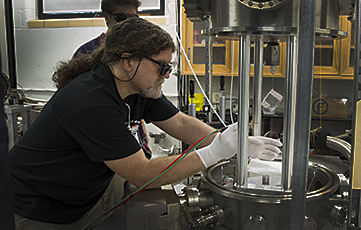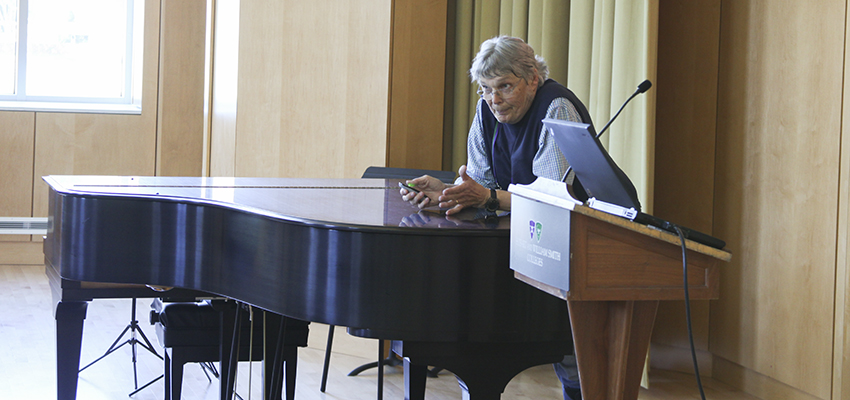
HWS News
1 June 2017 • Faculty • Research LIGO Detects Gravitational Waves for Third Time
Results Confirm New Population of Black Holes
HWS Professor of Physics Steven Penn Played Major Role in Mirror Substrate and Coating Design for LIGO Research Project
The international team of scientists behind the Laser Interferometer Gravitational-wave Observatory (LIGO), of which Professor of Physics Steven Penn is a prizewinning collaborator, has made a third detection of gravitational waves—ripples in space and time—demonstrating that a new window in astronomy has been firmly opened.
As was the case with the first and second detections, the waves were generated when two black holes collided to form a larger black hole. The first unprecedented detection that made international headlines in 2016 was announced to the public as part of a live press conference by the National Science Foundation (NSF). Penn hosted a public presentation at HWS.
The newfound black hole, formed by the merger, has a mass about 49 times that of our sun. This fills in a gap between the masses of the two merged black holes detected previously by LIGO, with solar masses of 62 (first detection) and 21 (second detection). The third detection is already making headlines, including an article in The New York Times.
“We have further confirmation of the existence of stellar-mass black holes that are larger than 20 solar masses—these are objects we didn’t know existed before LIGO detected them,” says MIT’s David Shoemaker, the newly elected spokesperson for the LIGO Scientific Collaboration (LSC), a body of more than 1,000 international scientists who perform LIGO research together with the European-based Virgo Collaboration. “It is remarkable that humans can put together a story, and test it, for such strange and extreme events that took place billions of years ago and billions of light-years distant from us. The entire LIGO and Virgo scientific collaborations worked to put all these pieces together.”
The new detection occurred during LIGO’s current observing run, which began Nov. 30, 2016, and will continue through the summer of 2017. LIGO is an international collaboration with members around the globe. Its observations are carried out by twin detectors—one in Hanford, Wash., and the other in Livingston, La.—operated by Caltech and MIT with NSF funding.
“The Universe has surprised us with the first three detections all coming from the merger of binary black holes of more than 20 solar masses,” says Penn, who has significantly contributed to the mirror substrate and coating design for the LIGO detectors. “Gravitational wave observations will transform our understanding of the universe. These intriguing results inspire the fundamental research, currently in progress, to build the future generation of gravitational wave detectors.”
Currently Penn chairs the LSC’s Coating Working Group, a subcommittee of the Optics Working Group, which is developing coatings for future detectors. Penn is a co-coordinator of a multimillion-dollar grant proposal to establish a LSC Center for Coating Research that will develop coatings for Advanced LIGO Plus, or A+, and future detectors. The A+ upgrade plans include improved mirror coatings and squeezed light, a process of adjusting the photon distribution to circumvent the quantum uncertainty limit.
Penn joined the LSC in 1998 while a postdoctoral fellow at Syracuse University. Hobart and William Smith became one of the first small colleges to join the LSC when Penn took a position in the Physics Department in 2002. Penn’s original LSC research was on the mirror design for Advanced LIGO. He discovered how to significantly reduce the thermal noise in the material fused silica, which led to the selection of fused silica for the Advanced LIGO mirror substrates and suspensions.
LIGO made the first-ever direct observation of gravitational waves in September 2015 during its first observing run since undergoing major upgrades in a program called Advanced LIGO. The second detection was made in December 2015. The third detection, called GW170104 and made on Jan. 4, 2017, is described in a new paper accepted for publication in the journal Physical Review Letters.
In all three cases, each of the twin detectors of LIGO detected gravitational waves from the tremendously energetic mergers of black hole pairs. These are collisions that produce more power than is radiated as light by all the stars and galaxies in the universe at any given time. The recent detection appears to be the farthest yet, with the black holes located about 3 billion light-years away. The black holes in the first and second detections are located 1.3 and 1.4 billion light-years away, respectively.
The newest observation also provides clues about the directions in which the black holes are spinning. As pairs of black holes spiral around each other, they also spin on their own axes—like a pair of ice skaters spinning individually while also circling around each other. Sometimes black holes spin in the same overall orbital direction as the pair is moving—what astronomers refer to as aligned spins—and sometimes they spin in the opposite direction of the orbital motion. What’s more, black holes can also be tilted away from the orbital plane. Essentially, black holes can spin in any direction.
The new LIGO data cannot determine if the recently observed black holes were tilted but they imply that at least one of the black holes may have been non-aligned compared to the overall orbital motion. More observations with LIGO are needed to say anything definitive about the spins of binary black holes, but these early data offer clues about how these pairs may form.
“This is the first time that we have evidence that the black holes may not be aligned, giving us just a tiny hint that binary black holes may form in dense stellar clusters,” says Bangalore Sathyaprakash of Pennsylvania State University and Cardiff University, one of the editors of the new paper, which is authored by the entire LSC and Virgo Collaborations.
There are two primary models to explain how binary pairs of black holes can be formed. The first model proposes that the black holes are born together: they form when each star in a pair of stars explodes, and then, because the original stars were spinning in alignment, the black holes likely remain aligned.
In the other model, the black holes come together later in life within crowded stellar clusters. The black holes pair up after they sink to the center of a star cluster. In this scenario, the black holes can spin in any direction relative to their orbital motion. Because LIGO sees some evidence that the GW170104 black holes are non-aligned, the data slightly favor this dense stellar cluster theory.
“We’re starting to gather real statistics on binary black hole systems,” says Keita Kawabe of Caltech, also an editor of the paper, who is based at the LIGO Hanford Observatory. “That’s interesting because some models of black hole binary formation are somewhat favored over the others even now and, in the future, we can further narrow this down.”
The study also once again puts Albert Einstein’s theories to the test. For example, the researchers looked for an effect called dispersion, which occurs when light waves in a physical medium such as glass travel at different speeds depending on their wavelength; this is how a prism creates a rainbow. Einstein’s general theory of relativity forbids dispersion from happening in gravitational waves as they propagate from their source to Earth. LIGO did not find evidence for this effect.
“It looks like Einstein was right—even for this new event, which is about two times farther away than our first detection,” says Laura Cadonati of Georgia Tech and the Deputy Spokesperson of the LSC. “We can see no deviation from the predictions of general relativity, and this greater distance helps us to make that statement with more confidence.”
“The LIGO instruments have reached impressive sensitivities,” notes Jo van den Brand, the Virgo Collaboration spokesperson, a physicist at the Dutch National Institute for Subatomic Physics (Nikhef) and professor at VU University in Amsterdam. “We expect that by this summer Virgo, the European interferometer, will expand the network of detectors, helping us to better localize the signals.”
The LIGO-Virgo team is continuing to search the latest LIGO data for signs of space-time ripples from the far reaches of the cosmos. They are also working on technical upgrades for LIGO’s next run, scheduled to begin in late 2018, during which the detectors’ sensitivity will be improved.
“With the third confirmed detection of gravitational waves from the collision of two black holes, LIGO is establishing itself as a powerful observatory for revealing the dark side of the universe,” says David Reitze of Caltech, executive director of the LIGO Laboratory. “While LIGO is uniquely suited to observing these types of events, we hope to see other types of astrophysical events soon, such as the violent collision of two neutron stars.”
LIGO is funded by the National Science Foundation (NSF), and operated by MIT and Caltech, which conceived and built the project. Financial support for the Advanced LIGO project was led by NSF with Germany (Max Planck Society), the U.K. (Science and Technology Facilities Council) and Australia (Australian Research Council) making significant commitments and contributions to the project. More than 1,000 scientists from around the world participate in the effort through the LIGO Scientific Collaboration, which includes the GEO Collaboration. LIGO partners with the Virgo Collaboration, a consortium including 280 additional scientists throughout Europe supported by the Centre National de la Recherche Scientifique (CNRS), the Istituto Nazionale di Fisica Nucleare (INFN), and Nikhef, as well as Virgo’s host institution, the European Gravitational Observatory. Additional partners are listed at: http://ligo.org/partners.php.
Written by Whitney Clavin/Caltech
Media Contacts:
HWS, Catherine Williams, Vice President for Communications, 315-781-3696 (office) cwilliams@hws.edu
MIT, Kimberly Allen, Director of Media Relations, Deputy Director, MIT News Office, 617-253-2702 (office) allenkc@mit.edu
Caltech, Whitney Clavin, Senior Content and Media Strategist, 626-395-8586 (office), wclavin@caltech.edu
NSF, Ivy Kupec, Media Officer, 703-292-8796 (Office) ikupec@nsf.gov
EGO–European Gravitational Observatory, Séverine Perus, Media Contact, severine.perus@ego-gw.it Tel +39 050752325

